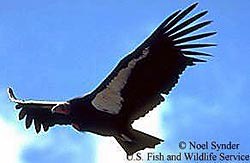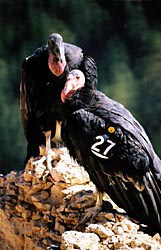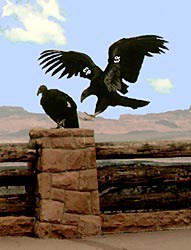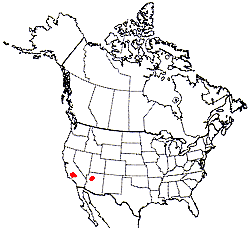|
Common Name (preferred): California Condor Scientific Name: Gymnogyps californianus Size (length, wingspan, & weight) English & Metric: Length—47" (1.19 m), Wingspan—108" (2.74 m), Weight—17-22 lbs. (7-10 kg) Habitat: Coastlines and Deserts Diet: Only Carrion Predators: Golden Eagles & Coyotes 
Noel Synder General Biology: Other birds are often mistaken for condors. Wishful thinking can often be to blame for such incorrect identifications. While in flight, California Condors can be distinguished from other large birds by carefully inspecting their wings. Turkey Vultures, Cathartes aura, are nearly twice as small as Condors, fly like they are intoxicated (rocking back and forth on V-shaped wings) and have light gray or translucent primary feathers on the edges of the wings. Condor wings, on the other hand, have white patches extending out of their "armpits", are held parallel to the ground while soaring, and fly with steady smooth beats. Juvenile Golden Eagles, Aquila chrysaetos, also very large birds, have white patches towards the end of their wings but can be distinguished from condors by their very distinct white tail band. If, however, you happen to see a bird that looks like it's the size of a small airplane and has numbers on its wings like an airplane, then you are one of the lucky few to have seen a California Condor in the wild. All condors living in the wild have large wing-bands with two-digit numbers that they can be seen while the bird is roosting or in flight. There is no sexual dimorphism (observable difference in size or appearance) between males and females. Condors were extinct in the wild until recently when two populations of condors raised in captivity were reintroduced into the wilds of Northern Arizona and Southern California. The recovery effort continues. 
NPS Behavior:
Although nestlings fledge (leave nest) fully grown at six months of age, juvenile condors may be dependent on their parents for more than a year. Reintroduced condors are released on their own and must learn to forage and survive alone.
Condors are strictly scavengers. Unlike Turkey Vultures, condors do not have an exceptional sense of smell. They instead find their food visually, ranging as much as 100 miles a day, often investigating the activity of ravens, coyotes, eagles, and other scavengers. Unfortunately, too many of the condors have had to learn the hard way that most of these other carrion-eating animals can be dangerous company and unlike other condors, are unwilling to share their spoils. Condor mortality is especially high when they come into contact with Golden Eagles and Coyotes, canis latrans. Without the guidance of their parents, young inexperienced juvenile condors may also investigate the activity of humans, which can get them into trouble. Condors can be somewhat gregarious. They usually roost together and even seek out food in pairs or larger groups. 
NPS Conservation: By the 20th century, California Condors occurred only in California, Nevada, and northern Mexico. It is speculated that, if not for beached whales along the California Coast and excessive grazing by sheep and cattle in the desert southwest, condors might have gone extinct long ago. By 1982, there were only 22 in the wild. The final decline was caused mainly by lead poisoning, pesticides, shootings, collisions with power lines, and loss of habitat. Emergency measures were needed and the Department of the Interior selected the Peregrine Fund to intervene after much controversy. Founded in 1970 in response to the decline in Peregrine populations, the Peregrine Fund are experts at captive breeding and release strategies. They have released over 4000 birds of various kinds into the wild. In 1987, the last of the wild population was captured and there are now three areas where birds are bred: Los Angeles Zoo, San Diego Wild Animal Park, and the Peregrine Fund facility in Boise, Idaho. In 1988, the first pair was bred successfully. By late 1995, there were 103 individuals. In January 1992, captive-raised young condors were released in several wilderness sites in their former range in California. In 1996, the first release of birds was done in Northern Arizona. Subsequent releases have raised the Arizona population to 31 birds, and as of September 2002, a total of 42 condors explore the skies of California. It is a goal of the program to have 150 birds in each of three areas: California, Arizona, and in the captive breeding program. There are now 119 birds breeding. There are three hurdles to overcome in establishing a self-sustaining wild population: 1. Maintain maximum survivability of released birds. This is accomplished by tracking closely, giving supplemental feedings and medications, as needed. 2. Encouraging natural foraging behavior ultimately allowing for no supplemental feeding. Many of the birds are now finding their own carcasses, usually cattle. 3. Upon reaching sexual maturity (5-6 yrs.) have pairing, breeding, and successful rearing of young. For current information contact California Condor Restoration Conservation Projects. 
When and where to see at Bryce: Never shoot at or throw objects at a condor. The California Condor, hawks, eagles, vultures, and owls are protected under the Migratory Bird Treaty and the Endangered Species Act. Under these acts, it is illegal to pursue, hunt, take, capture, kill, or attempt to do any of these activities to a bird of prey. If you should observe a condor in Bryce Canyon National Park, please report your sighting to a Park Ranger. Helpful information would include date, time, location, number of birds observed, and wing tag numbers, if possible. Further Reading: Dunn, John L. 1999. The National Geographic Field Guide to Birds: 3rd Edition. National Geographic, Washington D.C. Erlich, Paul R. et al. 1988. The Birder's Handbook: a field guide to the natural history of North American Birds, Simon and Schuster/Fireside Books, New York Sibley, David Allen. 2001. The Sibley Guide to Bird Life and Behavior. Knopf Publishing |
Last updated: April 20, 2022
